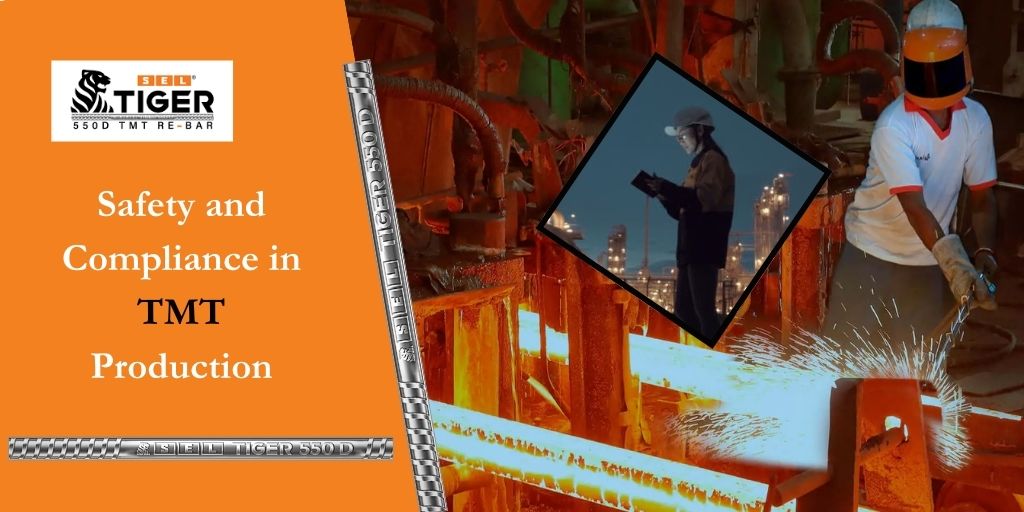
The Indian construction industry is seeing a boom with increasing demand for modern infrastructures. With the emerging needs, the need to comply with the safety regulations have also become paramount. This increased need for safety has made it important to use materials that ensure safety to both life and property. Among the various construction materials, TMT bars have a huge role to play in ensuring the safety and compliance measures. As the demand for quality steel bars increases, it is important that you know about the ways in which safety and compliance measures are maintained by TMT bar manufacturers during production.
TMT or Thermo-Mechanically Treated bars are specially designed steel bars with enhanced properties. These bars have made a name for themselves because of their strength and durability. With respect to the modern day construction industry, TMT bars are the backbone for every major project. The diverse grades ranging from Fe415 to Fe 600D and width ranging from 5.5 mm to 32 mm, make S-E-L Tiger TMT Re-Bars the ideal material for all your construction needs.
The most important element that helps distinguish TMT bars from other conventional steel bars is the manufacturing process. It is this unique process that gives the steel bars the desired mechanical properties. The entire process involves three major stages of heat rolling, quenching and self-tempering. During the heat rolling, steel billets are heated at around 1200 degree Celsius making it soft enough to get the desired shape. After the heat rolling stage, the hot bars are cooled down using a quenching method. During this process, the bars are passed through a high pressure cooling system rapidly to harden the outer layer. On passing through the quenching stage, the bars are left to cool down naturally. This allows the hot core to form a uniform structure throughout the bar. Because of the manufacturing process, the outer layer becomes hard leaving the inner layer soft for better strength, durability and flexibility.
TMT bars have a reputation for being highly reliable when it comes to major construction projects. This reputation is the result of adhering to the strict safety and compliance protocols set in place for steel manufacturing. During the entire manufacturing process, certain points need to be kept in mind by the TMT bar manufacturers to produce high quality bars. Some of the key points to remember are:
The changing regulations and market trends are key to ensuring safety and compliance in TMT productions. In order to stay competitive and ensure compliance, the demand for high-strength bars is met through the production of bars of higher tensile strength. With the increasing focus on sustainable living, efforts are taken to reduce carbon footprint and optimal use of resources. Just following the safety and compliance measures won’t get the desired results for the manufacturers. They need to make sure that the customers are aware of their efforts through digital platforms for better customer engagement.
Read Also: Navigating Building Safety: A Comprehensive Guide to TMT Bars and Building Codes
TMT bars hold an important position as a reliable material in the modern construction industry. Over the years, TMT bar manufacturers have undergone drastic changes to meet the evolving needs of infrastructure and urban development. As the demand for construction projects increases, it is important to ensure that the structures are safe, durable and compliant to the regulations. With both government and private sectors investing heavily in the development, use of quality bars is key to the efforts. The growing dependency on steel bars for infrastructural development makes steel manufacturers an important player. With manufacturers like SEL Tiger TMT, you not only get quality TMT bars but also trust, reliability, and a commitment to a sustainable future.
Essential safety measures include proper use of personal protective equipment (PPE), regular equipment maintenance, clear safety protocols, and employee training.
Manufacturers can ensure worker safety through rigorous safety training, adherence to safety standards, regular inspections, and maintaining a safe working environment.
Regular maintenance checks should include inspection of machinery for wear and tear, lubrication of moving parts, and ensuring proper calibration and functioning of safety devices.
Environmental impacts include energy consumption, emissions of pollutants, and waste generation, which can be mitigated through efficient practices and adherence to environmental regulations.
About The Author: Sushil Singh has over the past decade gained extensive experience in the field of construction and infrastructure. With his vast knowledge, his writings are aimed at providing the readers with valuable inputs on construction materials. All his work is focused on making it easy for the readers to make an informed decision when it comes to choosing the right material for their respective construction projects.